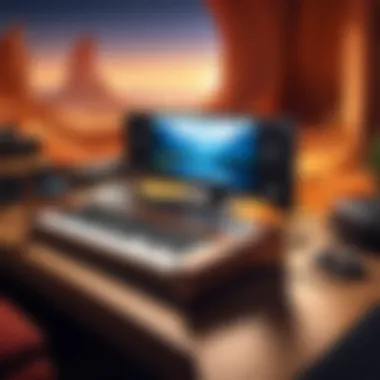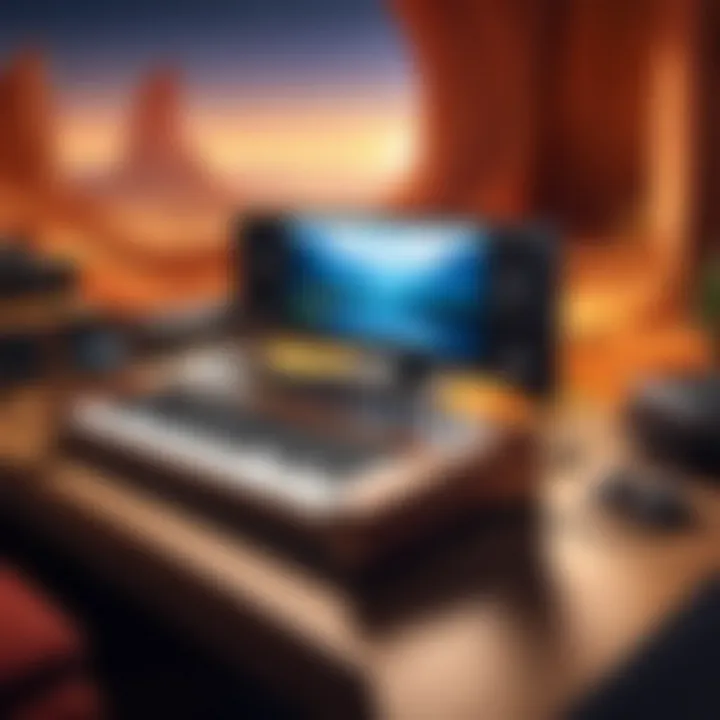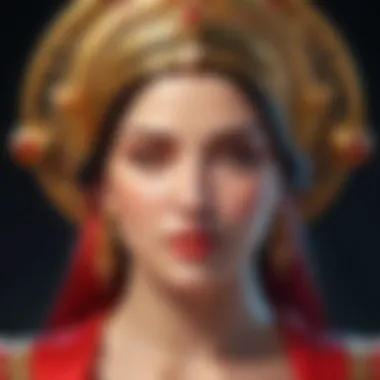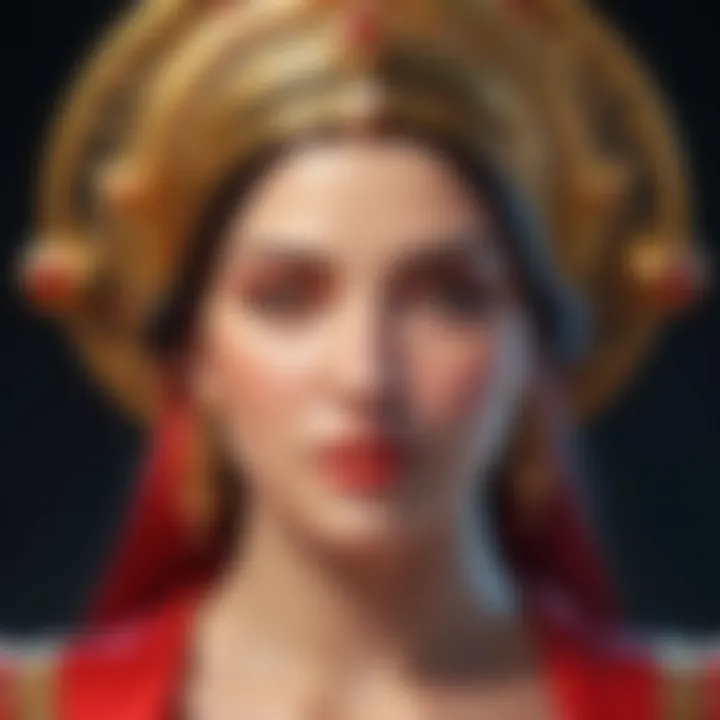Opera for Gaming: Merging Art with Digital Play


Intro
The fusion of opera and gaming marks a unique convergence of two seemingly disparate art forms. This collaboration illustrates how classical music can enhance modern gaming experiences, transcending traditional boundaries. The exploration begins with an understanding of technology and artistic expression's role in enhancing player engagement and narrative depth.
Gaming is often viewed through a lens focused on graphics and gameplay mechanics, yet the soundtrack plays a pivotal role. The auditory element shapes emotions, enhances immersion, and influences player decisions. Incorporating operatic scores could significantly elevate these aspects. This synergy not only captivates players but can redefine storytelling in interactive environments.
In the following sections, we will delve into the technical aspects and design philosophies that govern this artistic fusion. By examining various case studies and future trends, we will illuminate how opera's rich layers can breathe life into digital experiences.
Preface to Opera in Gaming
The convergence of opera and gaming represents a rich and intricate exploration of artistic boundaries. This section serves to illustrate the potential of operatic elements in gaming. Such integration is not just about adding a layer of music but also about enhancing emotional narratives and player immersion. The æsthetic qualities of opera can greatly amplify the thematic depth of games, offering players an experience that resonates on multiple levels.
Defining Opera and Gaming
Opera is a fusion of music, drama, and visual art. Traditionally, it tells stories through the interplay of voices and orchestration. Each performance is a unique experience, shaped by the production's vision. On the other hand, gaming is an interactive medium where players engage actively with the narrative. It examines player decisions, relationships, and the broader virtual environment.
At first glance, these two art forms may appear vastly different, but they share core elements. Both require a complex orchestration of sound, emotion, and performance. Therefore, understanding their definitions helps to appreciate their potential synergy.
Historical Context: A Relationship Unveiled
The historical connections between music and gaming can be traced back to the earliest video games. From the simple chiptune compositions in titles like Pong to grand orchestrations in modern role-playing games, music has always played a key role in creating atmosphere.
Opera’s influence began to emerge significantly in the digital age. Games started to incorporate operatic scores or references, creating compelling narratives that drew from classical themes. For instance, Final Fantasy incorporates orchestral music that evokes operatic styles, enhancing both story and engagement. This historical relationship reveals an evolving narrative where operatic elements enrich gaming, bridging the gap between high culture and interactive entertainment.
"Understanding how these elements intertwine allows us to appreciate deeper layers of storytelling within gaming."
In summary, the introduction of opera into the gaming sphere prompts a reevaluation of narrative structure and emotional depth. This section lays the groundwork for exploring how operatic elements can not only complement but also transform gaming experiences.
The Aesthetic and Historical Significance of Opera
The significance of opera extends beyond entertainment. It represents a confluence of art forms that encapsulate storytelling through music, drama, and performance. This medley has evolved through centuries and offers rich aesthetics that resonate with audiences. In the sphere of gaming, the incorporation of operatic elements can deepen player engagement, elevate narrative forms, and enhance the overall gameplay experience.
The Essence of Opera: Themes and Structure
At its core, opera blends complex themes with a structured format. Common themes include love, tragedy, and the struggle between good and evil. These powerful narratives are articulated through expressive music and intricate lyrics.
The structure of an opera typically includes overtures, acts, and various musical components such as arias, duets, and choruses. Each section serves a unique purpose, allowing emotions to be conveyed effectively. These layered approaches help build a connection between the audience and the characters, which gameplay designers can utilize to develop similarly intricate plots.
Key elements of opera that can inform gaming narratives are:
- Character Development: Characters often undergo significant transformations that can mirror player experiences.
- Emotional Resolution: The resolution of conflicts in opera mirrors the fulfilling endings players seek in video games.
- Musical Motifs: Recognizable musical themes can create a sense of familiarity and attachment to game characters or scenarios.
Incorporating these aspects invites gamers to engage with the story at a deeper emotional level, enhancing immersion.
Influential Operas and Their Cultural Impact
Several operas have left a lasting impact on culture, influencing not only future operatic works but also other art forms, including games.
Examples of influential operas include:
- Carmen: With its themes of passion and freedom, it illustrates how powerful emotions can drive narratives.
- The Magic Flute: This opera combines fantasy with psychological exploration, which resonates well with narrative-driven games.
- Aida: Its grand scope and themes of love and conflict offer a blueprint for epic storytelling seen in many role-playing games.
The cultural impact of these operas flows through various mediums. They shape societal views and inspire creativity across different artistic fields, including cinema and, indeed, gaming. A notable aspect is how these operas use music to influence emotions, a technique that gaming can adopt to enhance player experience.
"Opera that transgresses its original boundaries to find new life in gaming can spark deeper conversations and emotional engagements, reflecting the timeless nature of such narratives."
Understanding the cultural significance of opera provides valuable insight into how these elements can be woven into game design. By studying influential operas, game developers can create rich, multi-dimensional worlds that resonate with players, establishing a bridge between classical and modern art forms.
Gaming as a Medium for Narrative Expression


The significance of gaming as a narrative-driven medium is paramount in today’s digital landscape. Unlike traditional storytelling forms, video games provide an interactive experience, allowing players to engage with narratives in unique ways. The convergence of operatic elements within gaming enhances this experience, infusing depth and complexity into storytelling that is often absent in more passive formats.
In gaming, players do not merely observe a story; they actively shape it. This interactivity fosters a deeper emotional connection to characters and plotlines, encouraging players to invest their feelings into the outcomes of their choices. By incorporating operatic elements, games can amplify this effect through rich, emotive music and compelling dialogue. Such strategies resonate with players, leading to stronger narrative immersion.
Another benefit lies in the way games utilize branching narratives. Players often face choices that affect the plot's direction, providing multiple outcomes. This format parallels operas' various arias and themes, presenting diverging emotional arcs. The combination encourages players to explore different scenarios, much like revisiting a favorite opera performance to uncover nuances within the storyline.
Despite these advantages, there areconsiderations to weigh. Game developers must balance engaging narratives with gameplay mechanics to maintain player interest. If the operatic elements overshadow the core gameplay, it can lead to frustration or disengagement. Thus, a nuanced understanding of both narrative and game design is crucial.
Overall, gaming stands as a unique medium for narrative expression, capable of shaping powerful experiences. Incorporating operatic elements not only enhances storytelling but also elevates engagement, proving essential for future developments in the industry.
Storytelling in Video Games
Storytelling in video games often combines various narrative techniques. Developers can integrate linear storytelling, emergent narratives, or even episodic formats. This flexibility allows for the storytelling methods to align closely with operational themes found in traditional operas, where character relationships and emotional depth are pivotal.
Key Elements of Successful Video Game Storytelling:
- Character Development: Strongly defined characters allow players to form connections, much like how operatic protagonists evoke empathy through their struggles.
- Narrative Structure: Flexible narrative arcs enable the unfolding of complex storylines that can adapt to players’ choices, enhancing engagement.
- Emotional Resonance: Operatic scores can elicit specific emotions, creating a profound experience as players navigate the narrative.
Implementing these strategies, games aim to create rich narratives that immerse players, allowing them to share in the journey of characters as if they were part of a grand performance.
The Evolution of Musical Integration in Games
Musical integration in video games has transformed significantly since the early days of simple sound effects. Initially, music served as background noise, but it has evolved into a valuable narrative tool. Today, various genres, including operatic styles, are being used to enhance players' experiences.
The evolution can be viewed in several stages:
- Early Game Music: Basic tunes limited to hardware constraints, focusing on repetitive loops and simplistic melodies.
- Increased Complexity: As technology advanced, composers could create more intricate scores, allowing for themes to reflect gameplay changes.
- Adaptive Soundtracks: The modern era features dynamic compositions that change according to players' actions, providing a more personalized experience.
Incorporating operatic compositions something quite unique. The use of rich orchestration and powerful vocal elements can add a layer of emotional gravitas not often found in standard game music. Games like "Final Fantasy" series showcase the effective blend of operatic scores, captivating players and enhancing narrative depth.
Incorporating Operatic Elements in Game Design
In the realm of gaming, the integration of operatic elements holds significant potential for enhancing player experiences. This incorporation is not merely about adding classical music; it's about embedding a rich narrative and emotional depth that opera uniquely offers. The collaborative efforts of game designers and musicians can lead to an immersive atmosphere, increasing engagement and connection for players.
Musical Composition and Arrangement
Musical composition in gaming forms the backbone of player emotion and interaction. With operatic influences, developers can utilize a variety of musical techniques to elevate the auditory experience. The grand orchestral scores typical of opera can create an epic backdrop, instilling a sense of gravitas in key moments of gameplay.
Employing complex arrangements allows for dynamic changes during gameplay. For instance, a victorious moment can be underscored by a powerful crescendo, while moments of despair can be highlighted with softer, melancholic tones. Developers can also innovate by using leitmotifs—themes associated with characters or ideas—to deepen narrative connections as players progress through the game.
Using software like FMOD or Wwise, audio designers can implement adaptive music systems that respond to player actions. This adaptability can ensure that the operatic score evolves with the game, maintaining a tempo that reflects the player’s journey and emotional state.
Vocal Techniques and Performance in Games
Vocal techniques play a crucial role in the operatic experience. Unlike traditional game music, operatic performance invites an exploration of voice as an instrument in its own right. Character voices can use operatic styles to convey emotions intensely, influencing how players perceive narrative developments.
Incorporating trained opera singers can elevate the realism and emotional weight of in-game dialogues or cutscenes. Their expertise in techniques such as bel canto can add layers to the character's expressions, facilitating a powerful connection to the story. Additionally, creating unique vocal performances tailored for specific characters can enhance the gaming narrative.
Collaborative platforms like Reddit and Facebook can provide forums where players discuss the impact of these operatic elements. Insights shared by audiences can guide developers to understand better what resonates within their games.
"The application of opera in gaming can redefine emotional landscapes, creating a richer, more memorable experience for players."
Case Studies of Operatic Influence in Popular Games
The integration of operatic elements in gaming offers a fascinating perspective on how classical art can shape modern interactive experiences. This section explores various case studies that exemplify this blend. Each title discussed highlights the unique facets of operatic influence, serving as critical examples of how music and narrative intertwine in video games. Through these analyses, readers can appreciate the benefits and consequences of introducing operatic components in digital environments.
Analysis of Specific Titles
Several notable titles stand out when discussing the operatic influence on gaming. These games not only utilize operatic music but also weave rich narratives that resonate with themes found in classical opera.
- Final Fantasy VI: This game features a famous piece called "Dancing Mad," composed by Nobuo Uematsu. The song encapsulates various operatic structures, enhancing the dramatic tension during crucial moments, much akin to a climax in an opera's final act.
- The Legend of Zelda: Ocarina of Time: The use of the ocarina to play melodies is reminiscent of operatic arias, allowing players to engage with music to progress in the narrative. The incorporation of musical elements conveys emotional depth and creates memorable experiences for players.
- Hellblade: Senua's Sacrifice: This title employs voices and chants that feel operatic in nature, creating an immersive atmosphere that connects players to Senua's journey. The sound design enhances the emotional weight of the storytelling.


These games exemplify how operatic components not only contribute to the overall narrative but also enhance the emotional engagement that players experience.
Insights into Player Reception and Experience
Understanding player reception is vital in analyzing the impact of operatic elements within games. Various studies and player feedback highlight how music, particularly operatic compositions, can enrich the gaming experience. Here are some key insights:
- Emotional Resonance: Players report feeling a deeper emotional connection to the story and characters when operatic music underscores pivotal moments. This connection stems from the inherent drama present in opera, mirroring real-life emotions.
- Enhanced Atmosphere: Many gamers note that the presence of operatic music creates a more captivating game world. This atmosphere can lead to increased immersion, allowing players to feel as if they are part of an expansive narrative.
- Cultural Appreciation: Some players express a newfound appreciation for opera due to its inclusion in games. In this way, gaming acts as a bridge, introducing a broader audience to the classical genre.
Ultimately, operatic influence in gaming results in richer narratives and greater emotional engagement. These case studies and insights combined illustrate how opera's timeless elements can harmonize effectively with modern digital storytelling.
The Impact of Opera on Player Immersion
The integration of opera within gaming presents a profound opportunity to elevate player immersion. This relationship is built upon the understanding that both fields evoke deep emotional responses through storytelling and performance. As games increasingly strive to engage players on multiple levels, operatic elements offer a unique advantage that enhances the experience beyond mere gameplay.
Emotional Engagement Through Music
Music is a powerful enhancer of emotional engagement. In opera, the vocal performance and orchestration stir profound feelings, often reflecting complex narratives and human conditions. When these elements are brought into gaming, they create moments that resonate deeply with players. For instance, consider the role of Berserk in Final Fantasy VI. The tragic opera sung in the game captures the essence of loss and despair, allowing players to connect emotionally with the characters.
The key benefits of this engagement include:
- Enhanced Character Development: Characters often have deeper story arcs when supported by operatic music.
- Increased Memorability: Players are more likely to recall emotional moments when heightened by powerful vocal performances.
- Richer Storytelling: The use of operatic scores elevates the narrative structure, providing layers to the story that enhance player investment.
This emotional connection, fostered through music, contributes significantly to the sense of being part of a larger story. The operatic context allows for a dramatization that is often missing in traditional game scores, leading to a more immersive atmosphere.
Creating a Multi-Sensory Experience
The concept of multi-sensory experience is crucial in modern gaming, and opera plays a vital role in this. By engaging multiple senses through music, visuals, and narrative, opera allows players to feel as if they are part of the game's universe.
Key aspects include:
- Visuals and Music Synchronization: Coordinated operatic performances with on-screen action create a seamless experience for players.
- Diverse Soundscapes: The orchestration in opera adds texture and depth, enveloping players in a vibrant audio environment.
- Physical Response: The intensity of operatic music can evoke physical reactions, ranging from adrenaline spikes to emotional responses, making gameplay more visceral.
Ultimately, the blend of operatic elements within gaming promotes a richer, more engrossing experience that can transport players to new realms. This multi-sensory approach not only reinforces the storyline but also enhances the overall gaming environment.
The fusion of opera and gaming reveals the potential for a truly immersive experience, enriching the lives of players in ways that transcend traditional gameplay.
Cross-Cultural Implications of Opera in Gaming
The intersection of opera and gaming offers a rich terrain for exploration, particularly regarding its cross-cultural implications. Both art forms have extensive histories and unique regional expressions. When opera is integrated into gaming, it not only enhances the gaming experience but invites players from diverse backgrounds to interact with cultural narratives that might be unfamiliar to them. This blending serves as a bridge, fostering appreciation for different traditions through an interactive medium. It’s essential to examine the dynamics at play in this confluence of art and technology.
Global Reception of Operatic Games
The global reception of operatic games reveals varied perspectives, shaped by cultural backgrounds and familiarity with opera. In regions where opera is a well-established art form, there can be significant appreciation for its incorporation into gaming. For instance, titles like Final Fantasy IX and Shadow of the Colossus, which integrate operatic scores or themes, often resonate well with players who have cultural ties to these musical styles.
Conversely, in areas where opera is less known, there might be skepticism or disinterest. However, games such as Transistor have actively used operatic themes to introduce unfamiliar audiences to this genre. With captivating narratives and engrossing gameplay, these games encourage players to engage with operatic elements even without prior exposure. The potential for widespread acceptance is evident, as players experience the emotional depth that opera brings to storytelling.
- Examples of games demonstrating global reception include:
- Final Fantasy IX: Integrating classic operatic motifs.
- Journey: Using choir and orchestral elements to enhance immersion.
Cultural Appropriation vs. Appreciation
Cultural appropriation in gaming, particularly regarding opera, raises important questions of ethical representation and respect for the source material. When developers use operatic styles or themes, they must tread carefully to avoid mishandling cultural elements that are not native to their backgrounds. The line between appreciation and appropriation is thin, and recognizing this distinction is vital.
It is essential for game developers to engage with operatic traditions authentically. Collaborating with cultural experts or local artists can enhance the integrity of the work. This ensures that the influences are presented thoughtfully, enriching the gaming experience rather than commodifying the art form. Creating a dialogue with the communities involved not only enhances the narrative authenticity but also paves the way for mutual respect and cultural exchange.
"When games portray opera with respect and insight, they can serve as cultural ambassadors, fostering understanding and connection across borders."
In summary, the cross-cultural implications of opera in gaming are profound. They present opportunities for expanding players' horizons while reminding developers to approach cultural influences with care and consideration. By doing so, the marriage of opera and gaming can yield enriching experiences that resonate well beyond their respective origins.
Future Trends: The Path Forward


As we explore the future of opera's role within gaming, it becomes essential to recognize how unique compositions can reshape our understanding of gameplay. Engaging musical experiences can enhance narrative structure and deepen emotional responses from players. The integration of opera in gaming presents opportunities to elevate artistic expression and redefine expectations within this medium. The convergence of these two worlds is not just about blending sounds; it is about enhancing engagement and providing players with a transformative experience.
Innovations in Game Composition
Innovation in game composition centers around expanding harmonic textures and intricate arrangements that classical opera can offer. Game developers are increasingly experimenting with how operatic scores can complement gameplay. Traditional gaming music often relies on loops and repetitive motifs, but operatic compositions introduce complexity and dynamic changes. This shift can lead to more profound emotional interactions as players traverse through various narrative arcs.
Game designers can leverage operatic elements to create more immersive soundscapes. As players encounter pivotal story moments, the music can swell and shift in a way that reflects the narrative's emotional weight. This approach not only enriches the gameplay but also allows a deeper connection between the player and the characters. Additionally, technology plays a crucial role as advancements in audio engines enable seamless integration of elaborate musical compositions into gaming frameworks, raising expectations for sound quality and engagement.
Potential Collaborations between Artists and Developers
The potential for collaboration between artists and developers is a crucial aspect of future trends in gaming. By merging the talents of orchestral composers with game designers, unique synergies can emerge that redefine genre conventions. Musicians with a background in opera can bring their understanding of dramatic arcs and character development into the sonic landscape of video games. This would create platforms where narrative depth is as significant as gameplay mechanics.
Cross-industry collaborations can result in original soundtracks that tell stories without words. Video games centered on operatic themes might emerge, offering experiences that feel almost cinematic. For instance, renowned artists like Hideo Kojima have previously integrated unique sound elements into his works, and this trend could expand with operatic influences.
"The future of gaming lies in its ability to merge emotions with technology through music and storytelling."
The ongoing evolution of gaming will continually seek to bridge these two distinct art forms to create richer experiences. As we face new challenges and possibilities, the path forward remains filled with promise, driven by creativity and exploration.
Challenges and Considerations
Addressing the challenges and considerations of incorporating operatic elements into gaming offers a nuanced understanding of the relationship between these two artistic domains. The interaction between artistic integrity and commercial viability is particularly complex. Developers must balance creative vision with market demands while navigating potential pitfalls that arise in both realms.
Balancing Artistic Integrity with Commercial Viability
Integrating opera into games necessitates maintaining artistic authenticity. Artistic integrity should not be sacrificed for potential profit. Gamers who appreciate opera expect high-caliber work. A project that appears financially motivated may alienate this audience. Conversely, developers often face pressure from publishers for broad appeal, which can dilute the operatic elements.
To achieve a balance, developers should focus on:
- Collaboration with musicians: Engaging with opera specialists can help ensure the authenticity of operatic elements.
- Targeted marketing: Identifying niche audiences allows for better alignment of artistic goals and commercial needs.
- Iterative design processes: Feedback loops that include both gamers and opera enthusiasts can refine the product.
Adhering to these elements helps foster a space where both financial success and artistic expression coexist.
Technical Limitations and Solutions
The integration of opera into video games is not solely an artistic endeavor; it also presents technical challenges. Game engines must effectively represent complex music scores and vocal performances. This includes the challenges of sound quality, synchronization, and resource management.
Several technical considerations include:
- Audio quality: High-fidelity sound is crucial for operatic performance. Developers should utilize advanced audio engines to capture the richness of operatic sounds.
- Dynamic soundscapes: Opera can enhance the immersive aspects of games. Adaptive audio technology must respond to player actions seamlessly.
- Resource allocation: Expanding the audio component can strain system resources. Effective optimization strategies are necessary to ensure that gameplay remains smooth.
Solutions to these challenges might involve:
- Investing in state-of-the-art audio tools: Tools like FMOD or Wwise can enable better sound management.
- Collaboration with technologists: Partnering with sound engineers can help circumvent technical hurdles.
"Dedicated effort in overcoming these technical challenges not only elevates the game's quality but also enforces the significance of operatic traditions in modern experiences."
By acknowledging and addressing these challenges, developers can create engaging experiences that resonate with players while respecting the depth of operatic art. It is essential for the future of opera in gaming to navigate these complexities skillfully.
The End: The Harmonization of Two Worlds
The intersection of opera and gaming presents a transformative opportunity to reshape narrative structures and emotional engagement within the gaming experience. As the digital landscape evolves, the infusion of operatic elements allows for deeper storytelling, significantly enhancing player immersion. This relationship demonstrates that combining classical art with modern technology not only broadens the artistic palette for developers but also enriches the experience for gamers.
In examining the influence of opera in game design, one can appreciate the complex dynamics at play. On one hand, operatic scores contribute to an emotionally charged environment, encouraging players to engage with their surroundings and narratives on a level that is both profound and aesthetically pleasing. On the other hand, developers must remain mindful of the technical limitations and commercial considerations that can arise when applying such artistic influences. Finding the balance between artistic integrity and expected market performance is crucial.
As opera continues to permeate the gaming industry, its role not only enhances narrative depth but also encourages a broader appreciation for cultural expression through gaming. The incorporation of operatic soundscapes can elevate a player's connection to the game, providing a multi-sensory experience that goes beyond mere entertainment. The recognition of opera's value in gaming thus holds promise for future advancements in both fields.
Summation of Key Insights
- Fusion of Art and Technology: Opera serves as a bridge between classical art and modern gaming, enhancing storytelling.
- Emotional Resonance: The operatic elements can deeply influence player engagement and emotional connection to the narrative.
- Cultural Appreciation: The collaboration between opera and gaming promotes an understanding of diverse cultural expressions.
- Industry Challenges: Developers face the challenge of marrying artistic visions with commercial viability.
"The blend of operatic richness with gaming innovation is not just an artistic choice but a necessary evolution of both mediums."
Final Thoughts on the Future of Opera in Gaming
The future of opera in gaming appears promising, as both industries stand to gain from this collaboration. Innovators within the gaming sector are increasingly recognizing the storytelling potential fostered by operatic music. With advancements in technology, the capability to seamlessly integrate live performances or high-fidelity recordings will be within reach, enriching the gaming experience even further.
Moreover, potential collaborations between composers and developers will likely spur novel approaches to game design, creating soundscapes that are as compelling as the narratives themselves. As more titles emerge that successfully blend these elements, we will likely see a cultural shift in how games are perceived—as not just interactive entertainment, but as a significant form of artistic expression akin to traditional opera.







